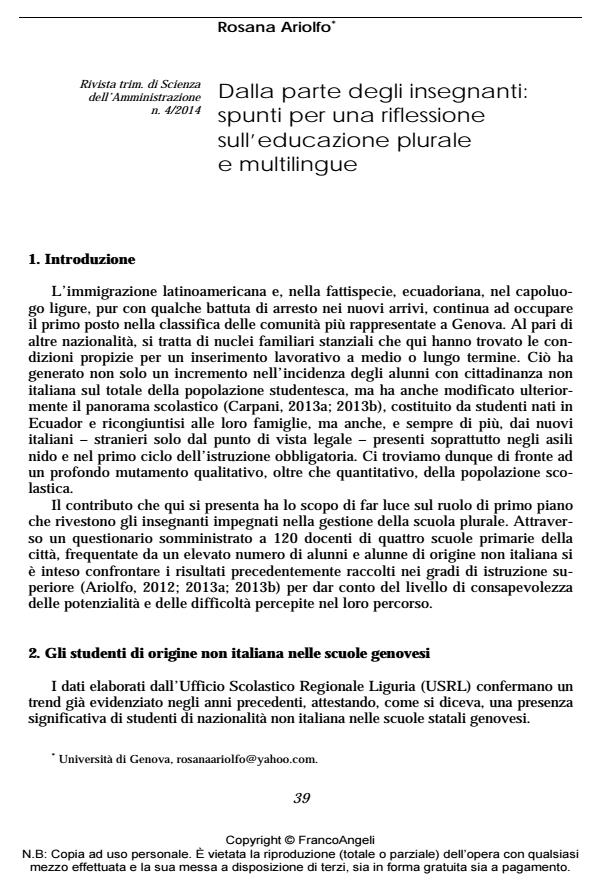From the teachers’ side: ideas for a reflection on plural and multilingual education
Journal title RIVISTA TRIMESTRALE DI SCIENZA DELL’AMMINISTRAZIONE
Author/s Rosana Ariolfo
Publishing Year 2015 Issue 2014/4 Language Italian
Pages 14 P. 39-52 File size 65 KB
DOI 10.3280/SA2014-004003
DOI is like a bar code for intellectual property: to have more infomation
click here
Below, you can see the article first page
If you want to buy this article in PDF format, you can do it, following the instructions to buy download credits

FrancoAngeli is member of Publishers International Linking Association, Inc (PILA), a not-for-profit association which run the CrossRef service enabling links to and from online scholarly content.
After a brief contextualization of the situation of the foreign school population who attends schools in Genoa, this contribution aims to shed light on some aspects of the educational situation in Genoa, in particular, on the vision that the school has regarding the use of the source language within the family and school contexts as well as to other issues related to such use and the possible solutions proposed by teachers. The analysis of the data emerging from the questionnaires submitted to teachers of four primary schools with a large number of foreign students was intended to stimulate the reflection among the parties involved in the school (Ariolfo, 2012; 2013a; 2013b) with the aim to encourage a deeper awareness of potentials, as well as the difficulties posed by schools with students with a foreign background (Lorenzo, 2011).
Keywords: Primary school, alloglot families, bilingualism
- Ariolfo R. (2010). Nuevas necesidades en la programación de cursos de español y en la formación de docentes de E/LE en el contexto migratorio genovés. In: Vera Luján A., Martínez Martínez I., a cura di, Atti del XX Congreso ASELE. Comillas: Fundación Comillas, ASELE, pp. 213-230.
- Ariolfo R. (2012). Actitudes lingüísticas, inmigración y escuela. Un aporte para la reflexión y la práctica educativa. Lecce: Libellula.
- Ariolfo R. (2013a). De la coexistencia a la convivencia de lenguas en el contexto escolar genovés. Revista Nebrija de Lingüística Aplicada 13. --Testo disponibile al sito: http://www.nebrija.com/revista-linguistica/revista-linguistica-nebrija13/htm/AriolfoRosana.htm (30/11/2014).
- www.nebrija.com/revista-linguistica/revista-linguistica-nebrija13/htm/AriolfoRosana.htm (30/11/2014).
- Ariolfo R. (2013b). Atteggiamenti linguistici nella scuola multiculturale. In: Carpani D.,
- Crovetto P.L., a cura di, Migrazioni, lingue, identità. Genova: ECIG, pp. 141-151.
- Ariolfo R. (2013c). Español lengua extranjera y español lengua inmigrada en el contexto educativo genovés. In: Blecua B., Borrell S., Crous B., Sierra F., a cura di, Atti del XXIII Congreso Internacional ASELE Multilingüismo y enseñanza de ELE en contextos multiculturales. ASELE, pp. 112-122.
- Berger P., Luckmann T. (1966). The Social Construction of Reality: A Treatise in the Sociology of Knowledge. Garden City New York: Anchor Books [trad. spa. La construcción social de la realidad (1968). Buenos Aires: Amorrortu editores].
- Carpani D. (2010). Nuovi cittadini, nuove prospettive della scuola interculturale: le ricerche sul campo a Genova. In: Calvi M.V., Mapelli G., Bonomi M., a cura di, Lingue, identità e immigrazione. Prospettive interdisciplinari. Milano: FrancoAngeli, pp. 119-131.
- Carpani D. (2013a). Juntos por un futuro más equitativo. Potencial del currículo plurilingüe en un barrio mestizo de Génova. Revista Nebrija de Lingüística Aplicada 13. --Testo consultabile al sito: http://www.nebrija.com/revista-linguistica/revista-linguistica-nebrija 13/htm/Carpani.htm (30/11/2014).
- Carpani D. (2013b). Lingue a contatto, scuola e interazione. In: Carpani D., Crovetto P.L., a cura di, Migrazioni, lingue, identità. Genova: ECIG, pp. 197-213.
- Cummins J. (1981). The role of primary language development in promoting educational success for language minority students. In: California State Department of Education, a cura di, Schooling and language minority students: A theoretical framework. Los Angeles: National Dissemination and Assessment Center, pp. 3-49.
- Lasagabaster D. (2005). La presencia de tres lenguas en el currículo: Multilingüismo en los contextos canadiense y español. Revista de Educación, 327: 405-426.
- Lorenzo F., Trujillo F., Vez J.M., a cura di (2011). Educación bilingüe. Integración de contenidos y segundas lenguas. Madrid: Síntesis.
- Piaget J. (1964). Six études de psychologie. Paris: Deonël [trad. spa. Seis estudios de psicología (1977). Barcelona: Ed. Seix Barral].
- Ravecca A. (2009). Studiare nonostante. Capitale sociale e successo scolastico degli studenti di origine immigrata nella scuola superiore. Milano: FrancoAngeli.
- Ravecca A. (2013). Introduzione alla ricerca. In: Centro Studi Medì, a cura di, Il passo seguente. Studenti stranieri nell’Università di Genova. Gonnosfanadiga: Centro Studi Medì, Linasprint, pp. 7-26.
- Selinker L. (1969). Language transfer. General Linguistics, 9: 67-92.
- Shotter J. (1994). Conversational realities. Constructing Life through Language. London: SAGE Publications [trad. spa. Realidades conversacionales. La construcción de la vida a través del lenguaje (2001). Buenos Aires: Amorrortu editores].
- Siguan M. (2001). Bilingüismo y lenguas en contacto. Madrid: Alianza.
- Vedovelli M. (2004). Italiano e lingue immigrate: comunità alloglotte nelle grandi aree urbane. In: Bombi R., Fusco F., a cura di, Città plurilingui. Lingue e culture a confronto in situazioni urbane. Udine: Forum, pp. 587-612
- The Use of the Present Perfect (pretérito perfecto compuesto) with Aoristic Value in the Speech of Latin American Students Rosana Ariolfo, in Languages /2019 pp.32
DOI: 10.3390/languages4020032
Rosana Ariolfo, Dalla parte degli insegnanti: spunti per una riflessione sull’educazione plurale e multilingue in "RIVISTA TRIMESTRALE DI SCIENZA DELL’AMMINISTRAZIONE" 4/2014, pp 39-52, DOI: 10.3280/SA2014-004003